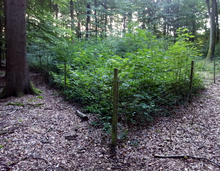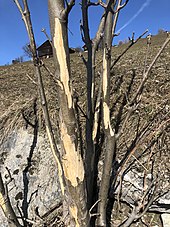Dogged
When browsing refers to the biting off of buds , leaves or branches especially on agricultural or forestry desirable plants. Browsing occurs by wild animals and farm animals . It can delay the growth of plants, form cripples and bonsai, and cause consequential damage through rot or cause a plant to die.
Browsed by farm animals

Browsing by farm animals such as sheep and goats can have a lasting effect on the vegetation. Examples are special hat forests for grazing animals. If browsing inhibits or prevents the growth of the desired vegetation, we speak of overgrazing , which - especially in combination with other environmental factors - can have far-reaching ecological consequences. Many cultural landscapes , for example heaths , only emerged through the keeping of livestock. Therefore, the attitude of sheep (and occasionally Buren goats partially within the) landscape maintenance promoted to the encroachment to prevent.
The avoidance of browsing and representation has, however, also led to a large number of landscape elements. Traditional corridor forms such as the ash corridor and the block corridor were associated with livestock farming, with the pasture areas tending to be on the edge of the district . The cattle were often driven back into the village along the fields in the evenings. The valuable fields were protected with hedges in order to avoid browsing and being represented . Knicks and Redder , which can still be found especially in northern Germany, owe their existence to this precautionary measure.
Game browsing


The browsing of plants by animal species that are subject to hunting law is called game browsing.
root cause
Ruminating hoofed game , but also the brown hare (Lepus europaeus) and the wild rabbit (Oryctolagus cuniculus) can be the cause . Even mice (Muroidea) affect forest regeneration, d. H. the regrowth of a young forest generation by eating roots, seeds and seedlings.
history
In Central Europe, the roe deer (Capreolus capreolus) and the red deer (Cervus elaphus) were decimated or almost completely disappeared in the aftermath of the bourgeois revolution . The alpine forests in particular were completely overexploited at that time and the natural regeneration or reforestation of these mountain forests initially took place in a “wild-free” environment.
Todays situation
Today the game stocks are actively managed on a high population level. The earlier collapses of the wild animal populations, triggered by harsh winters and excessive population density, are now missing due to the population controls. As a result, long periods of low game populations are missing. As a result of the now continuous game browsing, new tree generations can only form with difficulty.
Economic situation
Across Europe, high expectations are placed on the useful , protective and welfare functions of the forest, which leads to an increased conflict between forest, game and humans. Game browsing on a forestry culture or natural regeneration can lead to sensitive damage and high costs (e.g. for replanting). Depending on the density of hoofed game populations and the age structure of the forest, this can lead to increased browsing, reduced forest regeneration and even a loss of species in the forest.
Both formerly the livestock in the Hutewald and now only the hoofed game in the forest show clear preferences with regard to their choice of forage plants and thus influence the competitive advantages and mortality rates of the various plant species. Rowan berries (Sorbus aucuparia) and silver fir (Alba abies) are particularly popular forage plants.
The silver fir is particularly affected by this forest-game problem. This conifer species is currently very valued in the timber industry and fulfills an important function as part of the protective forest in the mountains. But oak , hornbeam , hardwood , beech , spruce , pine and birch also often have competitive advantages. Deer in particular prefer their food ( grazing ) based on their nitrogen content, which is high in the buds of deciduous trees in the earliest growth phase.
If hoofed game or rabbits cause economic damage, the injured party can usually claim damages. The forest authorities in most of the German federal states assess the damage caused by game browsing in forest regeneration in vegetation reports .
To prevent or reduce the bite, deterrents (olfactory, chemical) or mechanical bite protection are used. Direct protective measures are the construction of forest culture fences or the individual protection of individual plants with mechanical or chemical protection means.
In hunting law , the shooting quota for all hoofed game species has been adjusted for years. H. usually increased.
Law in Germany
The prevention and processing of unacceptable game damage is regulated in hunting law. Basically, the cooperation between the landowners as owners of the right to hunt, local forestry offices and authorized hunter for the development of a preventive planning measures such as hunting areas, construction of wild fields , compensation areas and quiet zones, arrangement of forest farm measures and of more effective hunting planning essential. The Federal Hunting Act requires that the main tree species occurring in the hunting area can be rejuvenated essentially without protective measures.
Switzerland
In Switzerland, game management and thus also the Verbis protection measures are determined by cantonal action plans in addition to the legal basis.
Similar damage
From biting off or jumps is used when lying under a tree shoots in striking amount. This is caused by squirrels on spruce and fir trees . It is not uncommon for the shoots of pines to break off at the drilling sites that the pine medullary beetle ( Tomicus piniperda ) has created on them.
Further damage is caused by sweeping with the antlers and peeling the bark. Soil changes and damage caused by representation occur mainly from herds of ungulates .
Dogging as a natural design factor
A completely different, because very positive definition of browsing results from considerations that have become known as the mega-herbivore hypothesis . They see game browsing not as a negative, anthropogenically caused problem, but as the remainder of the far more influential browsing consequences that would have created natural open areas in Europe and other regions of the temperate latitudes. Accordingly, the browsing of trees, not only by herbivores such as deer and deer, but also by bison , aurochs and wild horses (in the Pleistocene also by forest elephants , rhinos, etc.), would have ensured natural landscapes in Europe, in which by individual Solitary trees, shrubbery and short lawns would have created a park-like open land biotope. Arguments for this hypothesis include the niche of aurochs, bison and horse as grass-eater and inhabitants of open landscapes, the frequency of pollen from the light-needing and grazing-proof genera oak and hazel in pollen diagrams from Europe, as well as the great biodiversity of European short grass areas. According to this theory, the browsing problem is a purely economic, not an ecological problem, since the rejuvenation of the forest would not be a natural process anyway, as dense forests in the European lowlands did not occur before the arrival of humans.
literature
- Iain J. Gordon, Herbert HT Prins: The Ecology of Browsing and Grazing. (= Ecological Studies. No. 195). 1st edition. Springer, Berlin / Heidelberg 2008, ISBN 978-3-540-72422-3 .
- Wolfgang Schwenke (Hrsg.) Among others: The forest pests of Europe. A manual in 5 volumes. Volume 5: Vertebrates . Parey, Hamburg 1986, ISBN 3-490-11516-3 .
- Fritz Schwerdtfeger : The forest diseases. Textbook of forest pathology and forest protection. 4th edition. Parey, Hamburg 1981, ISBN 3-490-09116-7 .
Individual evidence
- ↑ W. Bäumler, W. Hohenadl: On the influence of small alpine mammals on rejuvenation in a mixed mountain forest in the Chiemgau Alps . In: Forstwissenschaftliches Centralblatt. Volume 99, December 1980, p. 207.
- ↑ Forestry Practice - Forest Protection: Browsing under the microscope . In: AFZ-DerWald. 22/2015.
- ↑ U. Breitenmoser: Large predators in the Alps: The fall and rise of man's competitors . In: Biological Conservation. Volume 83, No. 3, March 1998, pp. 279-289.
- ↑ E. Landolt: Report to the high Swiss Federal Council on the investigation of the Swiss high mountain forests. Weingart, 1862.
- ↑ J. Senn, H. Häsler: Wildverbiss: Effects and assessment . ( Memento from April 8, 2016 in the Internet Archive ) In: Forum for knowledge. 2005, pp. 17-25. (PDF)
- ↑ CM Wemmer: Biology and management of the cervidae. Smithsonian Institution Press, Washington, DC 1987.
- ↑ B. Jedrzejewska et al .: Factors shaping population densities and increase rates of ungulates in Białowieża Primeval Forest (Poland and Belarus) in the 19th and 20th centuries . In: Acta Theriologica. Volume 42, No. 4, 1997, pp. 399-451. (PDF)
- ↑ GF Peterken, CR Tubbs: Woodland regeneration in the New Forest. Hampshire, Since 1650 . In: Journal of Applied Ecology. Volume 2, No. 1, May 1965, pp. 159-170.
- ↑ C. Maizeret et al: Effects of Population Density on the Diet of Roe Deer and the Availability of their Food in Chize Forest . In: Acta Theriologica. Volume 34, No. 16, 1989, pp. 235-246. (PDF)
- ↑ M. Baumann et al.: Hunting in Switzerland. 2nd Edition. hep Verlag, Bern 2014, ISBN 978-3-7225-0143-7 .
- ↑ H. Mayer, M. Neumann: Structural and dynamic development comparison of the spruce-fir-beech primeval forests in Rothwald / Lower Austria and Čorkova Uvala / Croatia . In: Forstwissenschaftliches Centralblatt. Volume 100, No. 1, January 1981, pp. 111-132.
- ↑ H. Verheyden-Tixier, P. Duncan: Selection for Small Amounts of Hydrolysable Tannins by a Concentrate-Selecting Mammalian Herbivore . In: Journal of Chemical Ecology. Volume 26, No. 2, February 2000, pp. 351-358.
- ↑ J. Senn et al .: Impact of browsing ungulates on plant cover and tree regeneration in windthrow areas . In: For. Snow Landsc. Res. Volume 77, No. 1/2, 2002, pp. 161-170.
- ↑ C. Ammer: Impact of ungulates on structure and dynamics of natural regeneration of mixed mountain forests in the Bavarian Alps . In: Forest Ecology and Management. Volume 88, No. 1-2, November 1, 1996, pp. 43-53.
- ↑ Biodiversity Study: There are more plant species on European meadows than in the rainforest. Retrieved September 22, 2019 .


